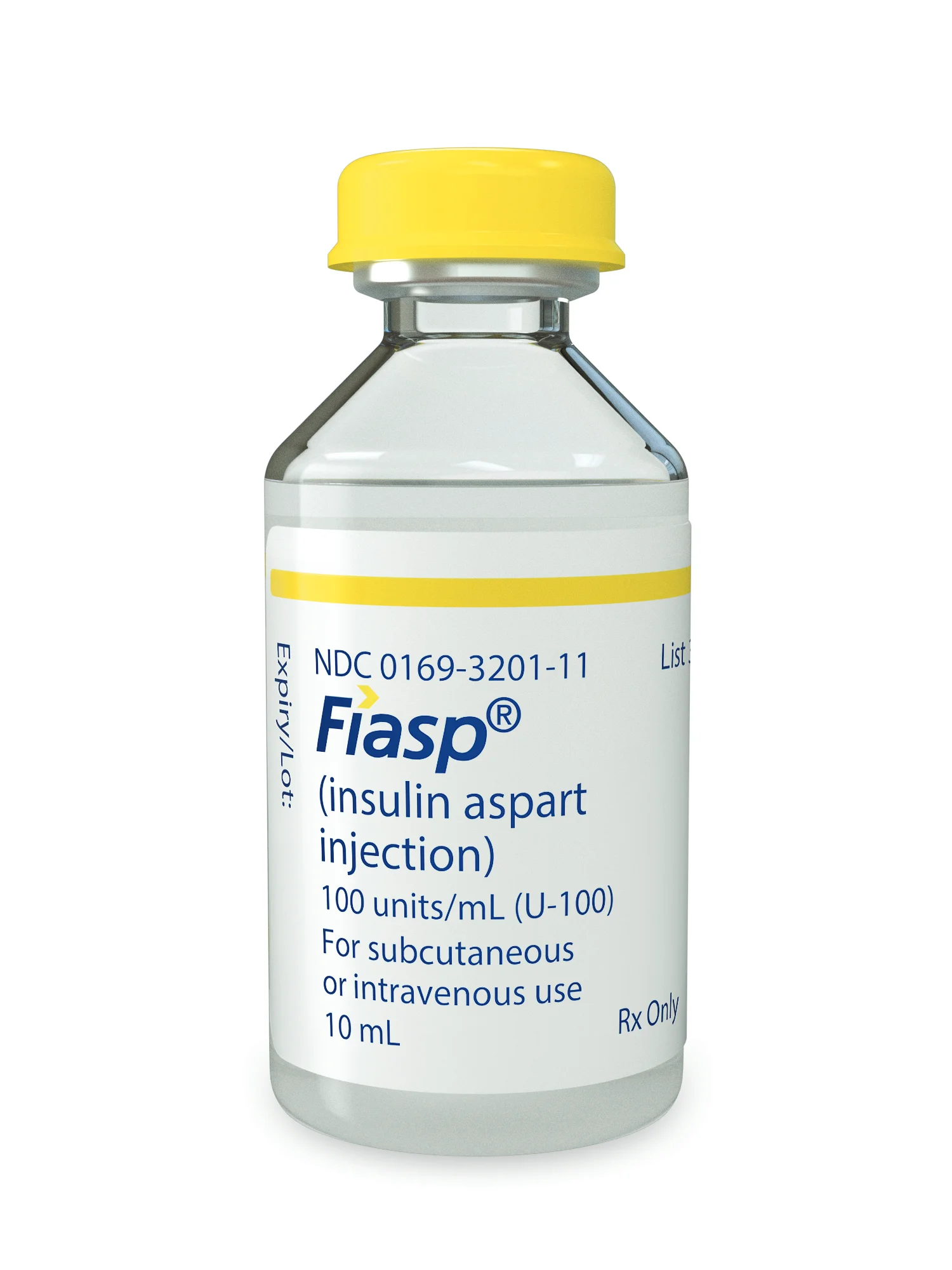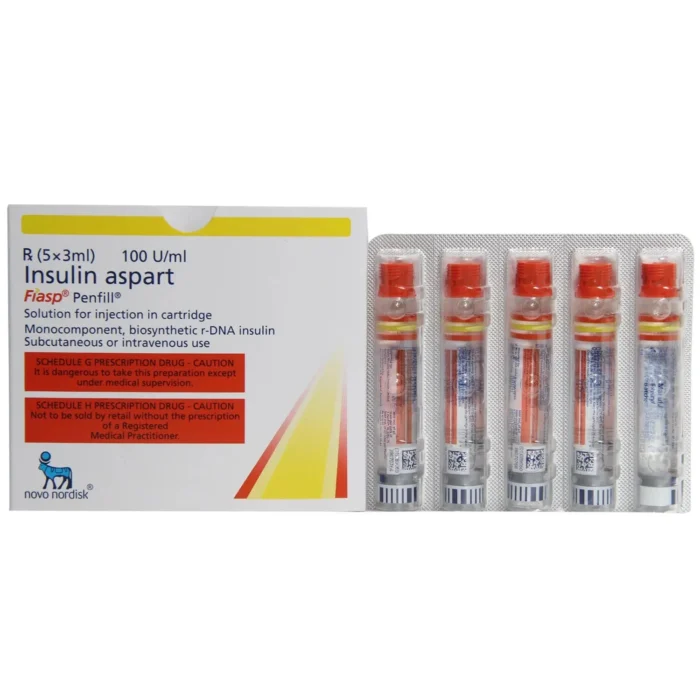- Home
- Diabetic Insulin
- Diabetic Test Strips
- Insulin Pen Needles
- 1/2″ 12.7mm Insulin Pen Needles
- 1/4″ 6mm Insulin Pen Needles
- 29 Gauge Insulin Pen Needle
- 3/16″ 5mm Insulin Pen Needles
- 30 Gauge Insulin Pen Needle
- 31 Gauge Insulin Pen Needle
- 32 Gauge Insulin Pen Needle
- 33 Gauge Insulin Pen Needle
- 5/16″ 8mm Insulin Pen Needles
- 5/32″ 4mm Insulin Pen Needles
- BD Insulin Pen Needles
- Easy Touch Insulin Pen Needle
- Gnp Insulin Pen Needle
- NovoFine Insulin Pen Needle
- Insulin Syringes
- Insulin Syringes Brand
- Glucometer Blood Glucose Meter
- Glucose
- Diabetes Control Solutions
- Diabetes Accessories
Fiasp Vials 10 ml 100 Units / mL
CAD $78.88 – CAD $331.84
Description
Fiasp Vials 100IU/ml Solution for injection is used for blood sugar control in individuals who have been diagnosed with type 1 and type 2 diabetes. It helps lower blood sugar levels after meals. Further, it reduces the chance of developing any diabetes complications, including kidney damage, nerve problems, loss of limbs, or eye damage.
Your doctor may prescribe Fiasp 100IU/ml Solution be used with a long-acting type of insulin or other medications for diabetes.
Fiasp (insulin aspart) vials are fast-acting insulin that closely matches the natural physiological insulin produced after a meal by a person who does not have diabetes. To increase the speed of absorption, Fiasp has included Vitamin B3 (niacinamide) as it is also used for stability, L-Argenine, a natural amino acid.
Unlike other common brands of insulin, Fiasp has a more flexible dosing regimen that allows you to inject up to 2 minutes before starting a meal or up to 20 minutes after starting a meal without compromising your overall safety and glycemic control.
Ensure you are ordering the correct insulin, as insulin aspart is available by Novolin in pens, vials and cartridges.
Fiasp insulin is also available through FlexTouch pens and cartridges
Before Taking Fiasp
A healthcare provider can only prescribe Fiasp. Please mention or note the below inquiries with your doctor.
The doctor may change your insulin dose if you have adrenal, pituitary, or thyroid problems.
If you are suffering from an infection, fever, or have recently had an operation, it is possible that you need more insulin.
When you have diarrhea, vomiting, or eat less than usual, the amount of insulin you need may be reduced.
Mention if you exercise more than usual or if you want to change your eating habits.
If you are sick, continue taking your insulin. Your need for insulin may change.
Changing time zones can affect the amount of insulin you need and when to inject it. If you plan to travel over time zones, speak to your doctor.
In case of pregnancy, conception planning, or breastfeeding, please consult your doctor.
Be alert for signs of hypoglycemia when driving or using machines. As your blood sugar drops, you won’t be able to concentrate or react as quickly. Be mindful of this rule in all situations in which you may endanger yourself or others.
You should tell your healthcare provider about all of the medicines you take, including prescriptions, vitamins, minerals, natural supplements, and alternative treatments.
Warnings
Do not share needles or pens with others, which can lead to serious health risks (such as spreading blood-borne pathogens).
Do not drink alcohol excessively while taking this medication, as it can significantly drop blood sugar levels.
If you are pregnant or breastfeeding, you should speak with your doctor to adjust your dosages accordingly.
If you have low blood glucose levels (hypoglycemia), you should not take this medication. Speak with your doctor about any health issues such as liver, kidney, or heart problems before starting treatment.
Any modifications to your insulin regimen can lead to hyperglycemia or hypoglycemia. This can include insulin strength, type, injection site, method of injection, or manufacturer. You should be under medical supervision for any changes to your insulin regimen with close blood sugar monitoring and frequency. Buy Fiasp Vials 100IU/ml
Like most insulin medications, always inspect the label for instructions before use.
Fiasp use can lead to life-threatening hypokalemia, followed by ventricular arrhythmia, respiratory paralysis, and death. It’s important to monitor potassium levels to measure risk for hypokalemia and treat as advised.
Heart failure and fluid retention may occur when combined with thiazolidinediones (TZDs), PPAR-gamma agonists, and insulin, including Fiasp. If a client is experiencing heart failure, then dosage reduction or discontinuation may be advised by your doctor.
Usage
Your physician or nurse will instruct you to inject it subcutaneously (under the skin) properly.
Fiasp insulin should be taken 15 minutes before your meal or within 20 minutes of starting a meal. It is essential to monitor your blood glucose levels regularly and keep track of results. Please share your results with your doctor so they can prescribe the correct dose that works for you.
Unless your doctor tells you otherwise, do not stop taking this medication.
Taking this diabetes medication should be part of your treatment, and a healthy diet, exercise program, and weight loss plan as advised by your doctor.
Pump or infusion set malfunctions can potentially lead to a rapid onset of hyperglycemia or ketoacidosis. Interim therapy with subcutaneous injection of Fiasp may be required. Patients using continuous subcutaneous insulin infusion pump therapy must be trained to administer insulin by injection and have alternate insulin therapy available in case of a pump failure. Buy Fiasp Vials 100IU/ml
Patients should rotate injection areas to avoid lipodystrophy or localized cutaneous amyloidosis.
Side Effects
The most common side effect related to Fiasp is hypoglycemia which in some cases may be life-threatening.
– Heart failure and fluid retention may occur with the concomitant use of thiazolidinediones (TZDs). Dosage reduction or discontinuation may be recommended if any severe symptoms or complications such as heart failure are experienced.
– As with other insulins, the use of Fiasp insulin can lead to other life-threatening hypokalemia, which may cause ventricular arrhythmia, paralysis, and even death. It’s important to monitor potassium levels to prevent hypokalemia and consult your physician if treatment is necessary.
– Infusion set or pump malfunctions can lead to ketoacidosis or rapid onset of hyperglycemia.
– Other adverse reactions may include allergic reactions, injection site reactions, weight gain, lipodystrophy, rash, pruritus, and hypoglycemia.
Call your doctor for medical advice about side effects.
Allergic Reactions
The active ingredient in Fiasp is insulin aspart. The non-medicinal ingredients are arginine (as L-arginine HCl), disodium phosphate dihydrate, glycerol, metacresol, niacinamide (vitamin B3), phenol, water for injections, and zinc (as zinc acetate). Hydrochloric acid and sodium hydroxide may be added for pH adjustment.
If you have a severe allergic reaction to the insulin or any of the ingredients in Fiasp, stop using Fiasp and see a doctor straight away.
In an allergic reaction, you may experience symptoms such as spreading of local reactions (e.g., rash, redness, and itching) or being sick or dizzy. Other signs include feeling unwell with sweating and having difficulty breathing. Buy Fiasp Vials 100IU/ml
Missed Dose
If you have missed a dose of Fiasp or not injected enough insulin, your blood sugar level may become too high (hyperglycemia). Check your blood sugar frequently.
Do not take a double dose to make up for a forgotten dose.
Overdose
You get hypoglycemia if your blood sugar gets too low. This might happen if you take too much insulin if you eat too little or miss a meal, if you exercise more than usual or if you drink alcohol.
The warning signs of hypoglycemia may come on suddenly and can include: cold sweat; cool pale skin; headache; slurred speech; fast heartbeat; feeling sick; feeling very hungry; temporary vision changes; drowsiness; unusual tiredness and weakness; nervousness or tremor; feeling anxious; feeling confused; and difficulty concentrating.
If you experience these signs, eat glucose tablets or a high sugar snack (sweets, biscuits, fruit juice) and then rest. Don’t take any insulin if you feel hypoglycemia coming on. If you can, measure your blood sugar if possible and rest. You may need to measure your blood sugar more than once. Relax until the signs of too low blood sugar have gone or when your blood sugar level has settled. Then carry on with your insulin as usual.
If severe hypoglycemia is not treated, it can cause brain damage (temporary or permanent) and even death. If you have hypoglycemia that makes you pass out, or if you get a lot of hypoglycemias, talk to your doctor. The amount or timing of your insulin dose, the amount of food you eat, or the amount of exercise you do may need to be adjusted.
Tell your relatives, friends, and close colleagues that if you pass out (become unconscious), they must turn you on your side and get medical help right away. They must not give you anything to eat or drink as it could choke you.
Storage
Not in use (unopened): If unopened, Fiasp vials should be stored in a refrigerator (36°F to 46°F [2°C to 8°C]) until the expiration date. If unopened but improperly stored outside of refrigerated conditions, begin in-use storage for a maximum of 4 weeks. Buy Fiasp Vials 100IU/ml
In use (opened): After first use, Fiasp vials can be stored at room temperature (below 86°F [30°C]) or in the refrigerator (36°F to 46°F [2°C to 8°C]) for a maximum of 4 weeks (28 days).
| Vials | 1 Vials, 2 Vials, 3 Vials, 4 Vials, 5 Vials |
|---|
Related Products
-
CAD $134.64
-
CAD $161.84 – CAD $753.44
Diabetic Test Strips
Insulin Pen Needles
- Home
- Diabetic Insulin
- Diabetic Test Strips
- Insulin Pen Needles
- 1/2″ 12.7mm Insulin Pen Needles
- 1/4″ 6mm Insulin Pen Needles
- 29 Gauge Insulin Pen Needle
- 3/16″ 5mm Insulin Pen Needles
- 30 Gauge Insulin Pen Needle
- 31 Gauge Insulin Pen Needle
- 32 Gauge Insulin Pen Needle
- 33 Gauge Insulin Pen Needle
- 5/16″ 8mm Insulin Pen Needles
- 5/32″ 4mm Insulin Pen Needles
- BD Insulin Pen Needles
- Easy Touch Insulin Pen Needle
- Gnp Insulin Pen Needle
- NovoFine Insulin Pen Needle
- Insulin Syringes
- Insulin Syringes Brand
- Glucometer Blood Glucose Meter
- Glucose
- Diabetes Control Solutions
- Diabetes Accessories



